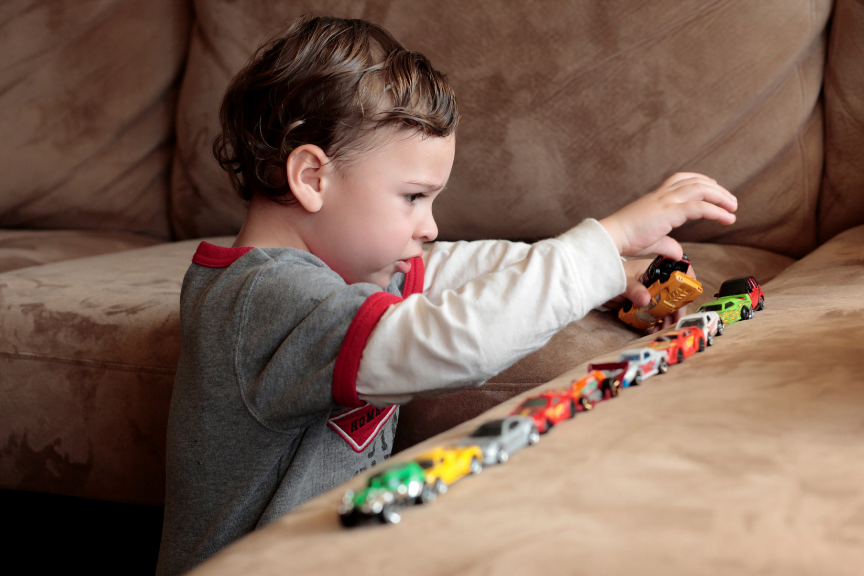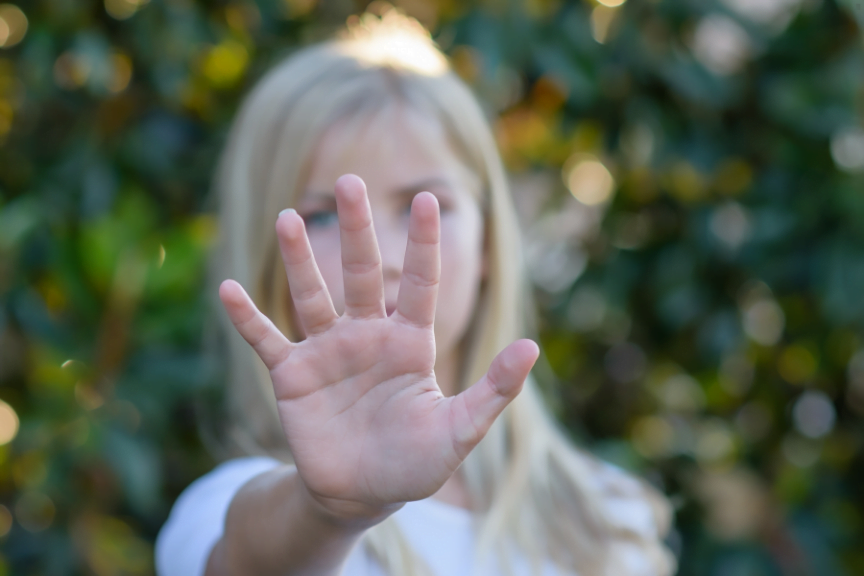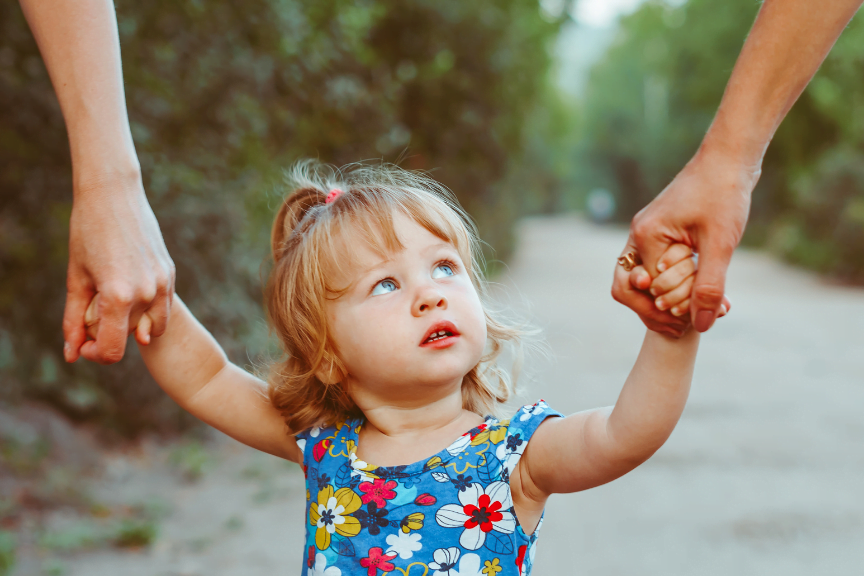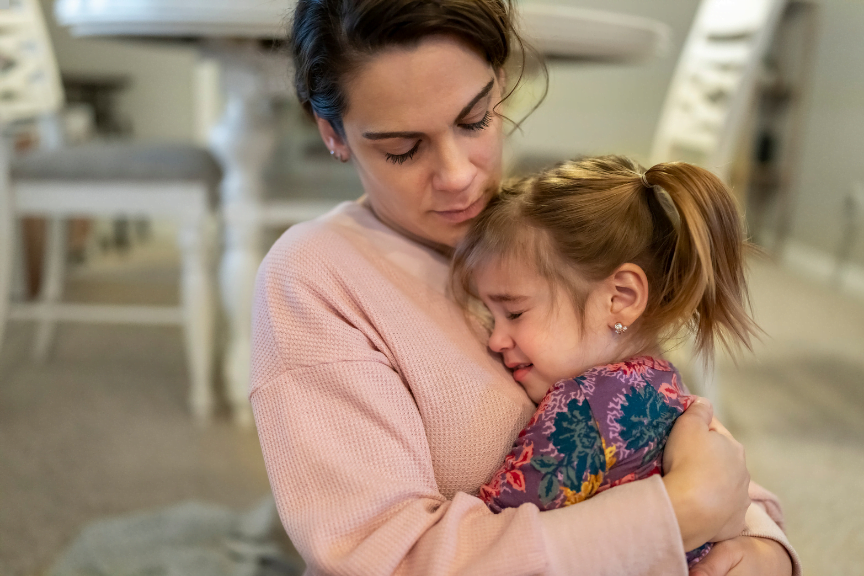What Are the Signs of Autism in Toddlers Age 2 Years?

Early signs of autism in toddlers under 2 include
- Avoiding eye contact.
- Not responding when you call their name.
- Not smiling back when you smile at them.
- Getting very upset if they don't like a certain taste, smell, or sound.
- Doing repetitive movements like flapping their hands, flicking their fingers, or rocking their body.
- Talking less than other children.
- Not engaging in pretend play as much as other kids.
- Repeating the same phrases.
The idea that your toddler might have autism will naturally bring a mixture of emotions and questions. But recognising and understanding these early signs of autism can mean getting a diagnosis quicker, and getting access to treatment and support for your family.
In this article we'll cover average development milestones and highlight early signs of autism your may notice in toddlers age 2 years or younger. You'll learn what steps to take if you have concerns, and how to find resources, support and further information about Autism.
Understanding Autistic Spectrum Disorders

What is Autism (ASD)?
Autism, or autism spectrum disorder (ASD), is a developmental condition that affects how a child communicates, interacts and experiences other people and the world around them.
While children on the autism spectrum usually sit, crawl, and walk on time. they have particular challenges with communication, language and social interaction.
Differences in gestures, play, and socialisation can be subtle and may be hard to differentiate in young children, hence the diagnosis is typically not made under 2 years old.
The term 'spectrum' is important because although there are common feature of autism, the specific symptoms an individual experiences can vary a lot.
Common Early Signs of Autism in Toddlers
While signs and symptoms can vary a lot there are some common early signs that many families affected by ASD report. Here are some of the top 3 early signs of autism.
Lack of Joint Attention

One of the most important developmental differences between children on the autism spectrum and children without ASD is a delay in or lack of joint attention.
Joint attention is behaviour like looking back and forth between an object or event and another person and connecting with that person and observe their reaction. Children with ASD tend instead to be very focusing on an object of interest, and can seem indifferent to whether anyone else is present or not.
Delays in joint attention skills are found in most children with ASD.
How can I tell if my child is developing joint attention skills?
By 12 months most children look at objects their parents point to and share expressions. Children with autism might ignore these gestures, causing parents to worry about their hearing.
By 15 months most children point and ask for objects they want. Children with autism might lead parents to objects without eye contact, sometimes placing the parent’s hand on the object.
By 18 months most children start to share objects or events of interest with others like parents or friends. Children with autism often point only to request items they want, and don't show interest in shared experiences.
Language and Communication Delay

Almost all children on the autism disorder spectrum show delays in both non-verbal communication and spoken language.
For example, you may notice differences such as delays in the age at which your child has their first word, beings to follow instructions, begin to name objects.
A child on the autism spectrum may have words they use to label things, but not to ask for things. They may use other means to get what they want, such as placing a parent or carers hand onto an item instead of asking for it.
What are common language differences in children with autism?
An early sign of autism in toddlers can be a parent noticing lack of non-verbal communication, particularly a lack of eye contact. For example your little one may seem to look through instead of at you, and be more focused on objects than other other people.
Children with autism may use words to label objects but not to ask for things. They might learn words for objects before people like names.
While many children repeat what they hear, those with autism might do this longer. They may echo dialogues from movies or conversations with the same tone, known as parroting or echoing.
Regression in Developmental Skills
About 25% of children later diagnosed with autism spectrum disorder may develop some language that they suddenly or gradually stop using.
This change is called a regression in skills. For example you may notice one or two words being used, but instead of language developing these either become fixed or are lost.
Difference or Dislike of Physical Contact

Many children who are diagnosed with autism show differences in how they respond to physical contact.
Children with an ASD can enjoy hugs and kisses, but they may appear to seek a very specific sensations. For example, they may only want to be touched in a certain place or way, and may get upset if any other type of physical contact is offered.
An early sign of an ASD which can be missed by parents and professionals is sensory seeking behaviours, particularly when excited or stimulated. Repetitive movements can be things like hand flapping, finger/toe wiggling, head banging, spinning wheels and touching water. While these can be part of normal development they are often more obvious and persistent in children who are later diagnosed with ASD.
Difficulty with Change in Routines

It is common for all children to struggle somewhat with changes to their routine, for example with getting dressed, ready for bed or leaving the playground.
However, children with ASD can find this particularly and increasingly hard to manage changes in their routine. This tends to worsen rather than improve as the grow and the develop and can interfere with a child's ability to do day-to-day activities.
Is my child's development normal?

In order to diagnose autism medical professionals compare a child's development to what is expected at specific ages and whether a child has reached certain specific 'milestones' in their development. Here is a summary of what 'normal' development.
It is important to note that children's early development varies a lot, and your little one not reaching a single milestone at a set time should not necessarily be a worry. It's about building a picture of a child's development overall and seeing patterns in how that development is progressing.
Typical Developmental Milestones
Understanding typical developmental milestones can help parents gauge whether their child's growth and development are on track.
The Centre For Disease Control (CDC) Milestone Tracker App is a useful tool to monitor developmental milestones.
Below is a summary of key early development milestones:
By 12 Months
By the time your child is 12 months old, they should typically be smiling and responding when their name is called. They should also babble, laugh, and be able to follow objects with their eyes, wave ‘bye-bye’, and point to objects
When placed on a firm surface, they should push down on their legs. It's also normal for them to show affection towards their primary caregivers and enjoy being cuddled. Gestures like waving or pointing are ways they might communicate their needs and interests.
By 24 Months
By the age of 24 months, your child should be reaching other developmental milestones.
They should be able to walk independently by 18 months, without walking only on their toes. They should also start to speak and imitate actions they see around them. Following simple instructions and understanding the function of common objects are signs of their growing understanding of the world.
The will show interest in exploring new objects, begins make-believe play.
By 36 Months
As your child approaches 36 months, their development should continue to progress. They should have expanded their speech to use short phrases and show interest in playing with other children.
They should be able to manipulate small objects and engage in pretend play, which are important for their cognitive growth. Difficulty with these tasks or frequent falls and struggles with stairs may be signs that further evaluation is needed.
They may enjoy sorting objects by shape and colour, naming a range of objects and people and engage in imaginative play.
What are Autism Red Flags?

There is no one symptoms or sign that is diagnostic for autism spectrum disorder in toddlers and young children. However, there are some signs that medical professionals use to indicate the need for further testing.
You can also take the Modified CHAT-R screening questionnaire. This a helpful initial tool to see if your child might need a professional evaluation.
Autism Signs in Babies (<1 year)
By 6 months: Few or no big smiles or joyful expressions, limited eye contact.
By 9 months: Little or no back-and-forth sharing of sounds, smiles, or facial expressions.
Autism Signs in Toddlers (1-3 years)
By 12 months: Little or no babbling, back-and-forth gestures, or response to their name. Avoidance of eye contact.
By 16 months: Very few or no words.
By 24 months: Very few or no meaningful two-word phrases.
Autism Signs in Older Children
Struggles with initiating or maintaining conversations, understanding social cues, and developing friendships.
Limited, repetitive behaviour patterns, interests, or activities.
Repetitive behaviours to calm or sooth ('stimming').
Loss of previously acquired speech or social skills.
Intense reactions to sensory experiences.
What to Do If You’re Concerned about Autism?

If you have concerns in your child’s development, it’s important to discuss them with your doctor or paediatrician early. They can provide guidance and perform assessments to determine if there are any developmental delays or concerns.
Early identification of issues like autism spectrum disorder allows for early intervention, which can significantly support your child's development and future outcomes.
Remember, the symptoms associated with ASD can also be related to other developmental disorders. Your healthcare team can help differentiate and provide appropriate resources and support for your child and family.
Seeking professional guidance early on can make a positive impact on your child’s development journey.
Will an Early Diagnosis of Autism Help my Child?
The American Academy of Paediatrics recommends that all children be screened for autism spectrum disorder at their 18- and 24-month well-child checkups.
Research shows that starting an intervention program as soon as possible can improve outcomes for many children on the autism spectrum.
When should I talk to my Doctor or Paediatrician?
If you have any concerns about your child's development, schedule an appointment with your paediatrician as soon as possible. Early intervention can significantly improve learning, communication, and social skills in children with autism.
Will an autism diagnosis help my child?
Early and accurate diagnosis of ASD in children has been shown to improve quality of life and access to early intervention services and support.
Recognising early signs and symptoms can help your child receive the help they need to learn, grow, and thrive.
At What Age Can Autism Be Diagnosed?
It is unusual for Health Professionals to diagnose autism before the age of two years, although many parents report they have seen signs long before this. One large study in the UK gave the average age of diagnosis as over 5 years old.
At What Age Can Autism Be Diagnosed?
Autism can be reliably diagnosed from the age of 2. The American Academy of Pediatrics recommends screening at 18 and 24 months. Early intervention is crucial for improving outcomes in children with autism.
Take Homes
If you're concerned that your toddler may have autism, understanding early signs is crucial for timely diagnosis and support. Look for indicators like delays in communication skills, difficulty with social interactions, unusual responses to physical contact, and challenges with routine changes. It's normal for children to develop at different rates, but discussing any concerns with your doctor can provide clarity and guidance.
Early intervention, starting as early as 18 months, can significantly enhance your child's developmental outcomes.
By recognising and acting on these signs, you're empowering your child to receive the necessary support for their growth and well-being.
We hope you find this article helpful. The information included is provided for informational purposes only and is not intended as medical advice.
Additional Resources
Autism Speaks is a leading autism advocacy organisation providing resources, support, and information for individuals with autism and their families.
National Institute of Mental Health provides research-based information on autism spectrum disorder, covering scientific advancements and treatment options.
Autism Society UK provides information and support for individuals with autism and their families, including advice on accessing services and educational resources.
National Autistic Society is a leading UK charity offering information, support, and services to individuals on the autism spectrum and their families.

